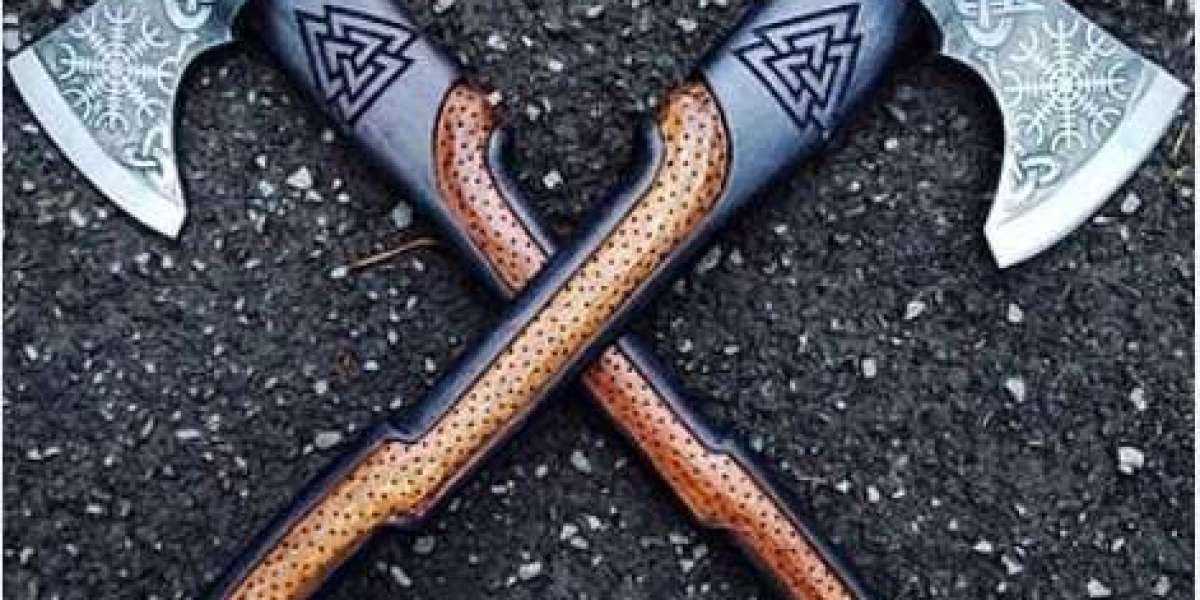Viking axes are among the most recognizable symbols of the Viking Age, known for their practical design and deadly efficiency. These axes varied in size, shape, and purpose, making them versatile tools and formidable weapons. In this article, we will explore the different types of Viking axes, their unique features, and how they were used both in daily life and in battle.
1. Hand Axes (Håndøkser)
Hand axes were small, one-handed tools that were widely used by Vikings for everyday tasks. These axes had a relatively short handle, typically around 30 to 40 centimeters (12 to 16 inches), making them easy to carry and maneuver. Hand axes were primarily used for chopping wood, carving, and other domestic chores. However, in times of conflict, they could also serve as weapons, allowing Vikings to defend themselves even when their primary weapon was not available.
Key Features:
- Short handle for easy handling.
- Lightweight and versatile.
- Primarily used for everyday tasks, but also effective in close combat.
2. Bearded Axes (Skeggøx)
The bearded axe is one of the most iconic and easily recognizable Viking axes, named for its distinctive shape. The term "bearded" refers to the extended lower part of the blade, which resembles a beard. This design provided several advantages: it allowed the axe to be used for precision cutting, increased the surface area for chopping, and provided a hook-like function that could be used to catch or pull an opponent's weapon or shield.
Key Features:
- Distinctive "beard" or extended lower blade.
- Versatile for both combat and woodworking.
- Useful for hooking and pulling techniques in battle.
3. Dane Axes (Danish Axes)
The Dane axe, also known as the Danish axe, was a large, two-handed weapon with a long handle, often between 90 to 120 centimeters (3 to 4 feet). The blade of a Dane axe was large and could be up to 30 centimeters (12 inches) in length, making it a powerful tool for delivering heavy blows. These axes were primarily used by Viking warriors, especially those of higher status, such as huscarls (personal guards) and elite soldiers. The long handle gave the Dane axe significant reach and leverage, making it a formidable weapon in open combat.
Key Features:
- Long handle for two-handed use.
- Large, broad blade capable of devastating blows.
- Preferred by elite warriors and used in open-field battles.
4. Broad Axes
Broad axes were characterized by their wide blades, which made them highly effective for cutting and chopping. These axes were often used in woodworking, especially for shaping logs and timber. The broad, flat blade allowed for clean cuts, making it a useful tool in building and carpentry. In combat, the broad axe could deliver powerful, sweeping strikes that were capable of causing significant damage to an opponent’s armor or shield.
Key Features:
- Wide, flat blade for effective chopping.
- Used in woodworking and construction.
- Capable of delivering powerful strikes in battle.
5. Throwing Axes
Throwing axes, also known as franciscas, were smaller axes designed to be thrown at enemies. These axes had a curved blade and were balanced for throwing, making them effective at short distances. Vikings would often throw these axes at the beginning of a battle to break the enemy's formation or to cause confusion. The francisca was not unique to the Vikings, but they adopted and adapted this weapon for their own use, demonstrating their willingness to incorporate different types of weapons into their arsenal.
Key Features:
- Curved blade designed for throwing.
- Balanced for accurate flight.
- Used to disrupt enemy formations and create openings in battle.
6. Long-Handled Axes
Long-handled axes, sometimes simply referred to as war axes, were designed for maximum reach and power. With handles that could exceed 1.5 meters (5 feet) in length, these axes allowed warriors to strike from a distance, keeping themselves out of immediate danger while still being able to reach their opponents. The long handle also provided leverage, making each strike more powerful. These axes were particularly useful in battle formations, where reach and striking power were crucial.
Key Features:
- Extra-long handle for extended reach.
- Powerful strikes due to increased leverage.
- Effective in battle formations and against multiple opponents.
Conclusion
Viking axes came in various shapes and sizes, each type serving specific functions both in daily life and in warfare. From the versatile hand axe used in everyday tasks to the fearsome Dane axe wielded by elite warriors, these tools were a testament to the Vikings' ingenuity and adaptability. The design and craftsmanship of Viking axes made them not only practical tools and deadly weapons but also enduring symbols of the Viking Age's strength and resilience. Today, these axes continue to fascinate and inspire, serving as reminders of a time when the Norsemen roamed the seas and left an indelible mark on history.








